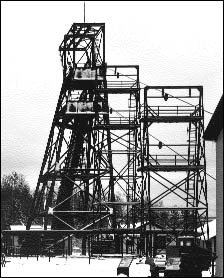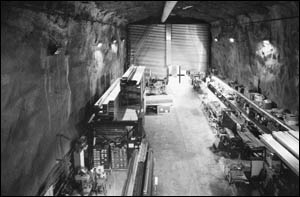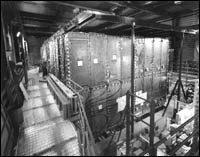The MINOS Experiment
Main Injector Neutrino Oscillation
Search

The headframe raises and lowers the elevator that
carries tourists, workers, materials and equipment
down into the historic Soudan mine. |
The MINOS experiment, using facilities
built by the Neutrinos at the Main Injector (NuMI)
Project at Fermi National Accelerator Laboratory, will
seek evidence for an extremely small mass for the
subatomic particles called neutrinos.
To detect such a small mass—if it
exists at all—requires observing the neutrinos after
they traverse a very long path. Such an experiment,
which interposes a long distance between the source of
the neutrinos and the neutrino detector, is called a
long-baseline experiment. Physicists have long
recognized the possibilities for new physics insights
offered by long-baseline neutrino oscillation
experiments. Finding a neutrino source of sufficient
intensity proved difficult, however. Like the beams from
flashlights, beams of neutrinos fade out as they travel
long distances. However, the new Fermilab Main Injector
accelerator, which began operating in 1999, has the
capability to provide intense neutrino beams, even at
the distance required for a long-baseline experiment.
The new Main Injector will serve as
the neutrino source for the MINOS experiment. The
experiment's long baseline will begin at Fermilab, 40
miles west of Chicago, and end deep in a former iron
mine in Soudan, a village in northern Minnesota, where
MINOS will place its neutrino detector—735 kilometers,
or about 450 miles, from the source.
Detectors Near and Far

The Soudan 2 lab, located in the underground
physics lab in the former iron mine. |
When the neutrinos arrive from
Fermilab (a trip that will take 0.0025 seconds) they
will encounter a massive detector, 5400 metric tons of
iron studded with plastic-strip particle detectors, 800
meters beneath the Minnesota woods. Because neutrinos
interact so rarely with other particles, only huge
masses of material offer the chance of creating—and
observing—an occasional interaction as the beam of
neutrinos sails through. The detector will measure
interactions of the neutrinos from the Fermilab beam,
detecting about 9,000 neutrino interactions each year,
out of five trillion neutrinos that pass through. A
sandwich of steel and plastic scintillator detectors
will measure the energy produced in the particle
interactions and record the momentum of outgoing muon
particles by tracking their paths as they go through the
magnetized steel plates.
MINOS experimenters will measure and
compare the properties of neutrinos as they leave the
Fermilab site, one kilometer from the source, and when
they arrive at the detector in Soudan. A difference
between characteristics of the neutrino interactions in
these two detectors would provide evidence for
oscillation between types of neutrinos, and hence of
neutrino mass. MINOS experimenters will build the near
detector as a small-scale replica of the far detector,
to make the two as similar as possible.
Physicists will build the new MINOS
far detector in the Soudan Mine underground physics
laboratory. A cavern in the underground lab is already
home to an existing particle detector built in the 1980s
to search for proton decay. On July 20, 1999,
collaborators broke ground for a second, larger cavern
to house the MINOS detector. The total cost for the near
and far MINOS detectors will be about $45 million, and
MINOS collaborators hope to begin taking data in 2003.
The Soudan Historic Site

Existing 1,000-ton detector in the Soudan mine. |
The Soudan Underground Physics
Laboratory, future home of the MINOS detector, is
located in the Soudan Underground Mine State Park,
operated by the Minnesota Department of Natural
Resources. As the first iron mine in Minnesota, the mine
is a registered national historic site. Mining
techniques at Soudan from the 1880s emulated those used
in Cornish tin mines. Mine operators recruited
immigrants from eastern Europe, including many Finns, to
create a work force that peaked at about 5,000 in the
1890s. Miners continued to extract pure hematite from
the mine until market forces brought operations to a
close in 1962. Park staff now provide public tours
underground for 30 to 40 thousand people annually. The
tours will continue during MINOS construction operation.
|